Videogames design supported in smartphones through interaction patterns
Keywords:
easy to use, interaction patterns, smartphones, videogamesAbstract
Since the moment they appeared in the 90s, software patterns have been a source of information when trying to solve recurring problems related to the creation and interaction of software. Nowadays, there is a variety of these patterns including interaction patterns, which are focused on solving problems related to direct communication between a user and different kind of software systems, such as videogames. Although interaction patterns have also been used in the context of entertainment software trying to improve communication between designers and players, it is not easy to identify which existing patterns could be considered to be adapted to the context of videogames supported in smartphones. In that sense, this article proposes and evaluates a set of interaction patterns focused on ease of use, adapted to the design of videogames supported in smartphones.
References
J. Juul and M. Norton, “Easy to use and incredibly difficult: on the mythical border between interface and gameplay,” in Proceedings of the 4th international conference on foundations of digital Games, 2009, pp. 107-112.
X. rubio Campillo, “El pasado en tu sofá: juegos de simulación histórica en entornos computacionales portables,” HER –Heritage and Museography, vol. V, número 2, pp. 55-62, Septiembre-Octubre
A. M. Moreno and M. Sánchez-Segura, “Patrones de Usabilidad: Mejora de la Usabilidad del Software desde el Momento Arquitectónico,” in JISBD, 2003, pp. 117-126.
F. J. Garcia Peñalvo, “Patrones. De Alexander a la Tecnología de Objetos,” Revista Profesional para Programadores (RPP), 1998.
J. Holopainen and S. Björk, “Game design patterns,” Lecture Notes for GDC, 2003.
S. Bjork and J. Holopainen, “Games and design patterns,” Cambridge, MA: MIT Press, 2006, pp. 410-437.
B. Huynh-Kim-Bang, J. Wisdom, and J.-M. Labat, “Design patterns in serious games: A blue print for combining fun and learning,” Project SE-SG, available at http://seriousgames.lip6.fr/DesignPatterns/ designPatternsForSeriousGames.pdf, 2010.
A. IBRAHIM, “Development Methodology Of Educational Video Game Based On Player-Centered Design,” in Computer Sciences and Telecommunications Engineering. vol. Ph.d. in Computer Science España: Universidad de Granada, 2012, pp. 89, 207.
J. L. González Sánchez, “Jugabilidad. Caracterización de la experiencia del jugador en videojuegos.” vol. Ph.d Granada: Universidad de Granada, 2012, pp. 143 -155, 199,234, 237.
I. S. Q. S. ISO, ISO/IEC 25010”, “Systems and software engineering — Systems and software Quality Requirements and Evaluation (SQuaRE) — System and software quality models,” 2011.
V. Abenójar Agudo, “Buenas prácticas de accesibilidad en videojuegos. Colección Estudios. Serie Dependencia,” Primera ed, IMSERSO, Ed. España: RIBERDIS, 2012, pp. 68-75.
ISO, “International Standard ISO/IEC 9241” in Ergonomic requirements for office work with visual display terminals, ed, ed., ed,1998.
J. M. Arteaga and G. R. Gómez, “Patrones de Interacción: Una Solución para el Diseño de la Retroalimentación Visual de Sistemas Interactivos,” 2004.
D. Pinelle, N. Wong, and T. Stach, “Using genres to customize usability evaluations of video games,” in Proceedings of the 2008 Conference on Future Play: Research, Play, Share, 2008, pp. 129- 136.
J. Tidwell, Designing interfaces, Patterns for Effective Interaction Design Canada: O’Reilly, 2009.
R. S. Deemedya.m.s. ltd.https://play.google.com/store/apps/ details?id=com.hyperkani.rope&hl=es_419, “ 2014.
N. C. https://play.google.com/store/apps/details?id=com.son.I_ wanna_be_the_hero&hl=es_419, “ I wanna be the hero,” 2015.
S. P. Hall and E. Anderson, “Operating systems for mobile computing,” Journal of Computing Sciences in Colleges, vol. 25, pp. 64-71, 2009.
A. F. S. Alegría, “Metodología para la evaluación colaborativa de la usabilidad de sistemas software interactivos,” in Facultad de Ingeniería Electrónica y Telecomunicaciones. vol. Doctorado en Ciencias de la Computación Popayán: Universidad del Cauca, 2015, pp. 30 -45.
H. Korhonen and E. M. I. Koivisto, “Playability heuristics for mobile games,” in Proceedings of the 8th conference on Human-computer interaction with mobile devices and services, 2006, pp. 2-8.
D. Pinelle, N. Wong, and T. Stach, “Heuristic evaluation for games: usability principles for video game design,” in Proceedings of the SIGCHI Conference on Human Factors in Computing Systems, 2008, pp. 1453-1462.
S. Papaloukas, K. Patriarcheas, and M. Xenos, “Usability assessment heuristics in new genre videogames,” in Informatics, 2009. PCI’09. 13th Panhellenic Conference on, 2009, pp. 202-206.
R. Inostroza, C. Rusu, S. Roncagliolo, C. Jimenez, and V. Rusu, “Usability heuristics for touchscreen-based mobile devices,” in Information Technology: New Generations (ITNG), 2012 Ninth International Conference on, pp. 662-667.
T. Tullis and B. Albert, Measuring the user experience: collecting, analyzing, and presenting usability metrics, Second ed.: Morgan Kaufmann, 2013.
S. Hernández, “Videojuegos casuales-Casual Games,” suite101, pp. http://suite101.net/article/videojuegos-casuales---casualgames- a45152#.U4_tn3KSzCY, Jul, 03 2013 2013.








 Revista Entre Ciencia e Ingeniería
Revista Entre Ciencia e Ingeniería .png) entrecei@ucp.edu.co
entrecei@ucp.edu.co.png) ISSN (Impreso) 1909-8367 - ISSN (En Línea) 2539-4169
ISSN (Impreso) 1909-8367 - ISSN (En Línea) 2539-4169 Attribution-NonCommercial 4.0 International (CC By-NC 4.0)
Attribution-NonCommercial 4.0 International (CC By-NC 4.0)
.png) Carrera 21 No. 49-95 Av. de las Américas, Pereira, Risaralda, Colombia
Carrera 21 No. 49-95 Av. de las Américas, Pereira, Risaralda, Colombia